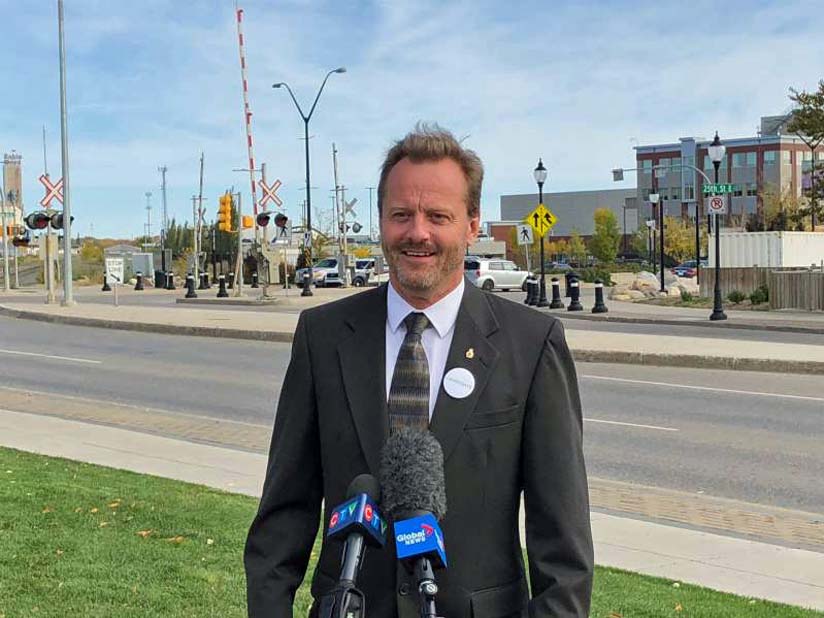
Saskatoon Saskatchewan - Cary Tarasoff is proposing a new solution to the rail debate in Saskatoon.
"Here's the third option that nobody wants to talk about, and nobody considered," the mayoral candidate said.
"We go under the city."
Speaking at the corner of 25th Street West and Idylwyld Drive, where Canadian Pacific (CP) tracks dissect the city, he outlined an option he said should have
always been included in the discussions.
He said specifics would be determined at a future date, likely during planning meetings, but described a tunnel that would start and end outside of the
city.
Trains could pass underneath Saskatoon and its entire infrastructure to re-emerge on the other side with no disruption to traffic.
"It's a guaranteed straight shot for the rail companies. So they can pick their starting point and their ending point, so their existing rail lines will
stay operational."
Tarasoff said construction wouldn't affect drivers in the city, that a tunnel would be safer and far quieter.
He also wouldn't provide an exact cost for the plan, saying that this option shouldn't be pursued just yet.
Tarasoff said the city shouldn't undertake any major and expensive projects while it recovers from the COVID-19 pandemic and subsequent economic
consequences.
In the meantime, he said CP and Canadian National (CN) railways should reduce the number of cars on trains that go through the city.
Saskatoon officials have previously discussed moving the tracks outside of the city or building over and underpasses so that train traffic is less
disruptive.
Both CN and CP railways have shut down one or both options.
In a letter submitted to a committee meeting in July, a senior CP vice-president wrote that moving the tracks is "fundamentally unworkable" because
either option would constrain the capacity.
And sharing the tracks, according to the letter from a public affairs manager at CN, isn't feasible because it reduces the flexibility of both
companies.
David Elwood, a University of Saskatchewan engineering professor, said the tunnel would alleviate the logjams of Saskatoon traffic and create between 400 and
500 jobs.
But he also warned the logistics around digging the tunnel and ventilating the diesel exhaust would present formidable challenges.
He also said the price would be "phenomenal."
"That cost is beyond what most provinces and cities can afford realistically. We're not talking a kilometre long tunnel, we're talking several kilometres
long. And tunnels of that length are not cheap," he said, speaking over Zoom.
Besides the cost, he said there was little incentive for the railways.
"They have their business interests, they've owned their property for a very long time. They've invested substantial amounts of money into their
property. It's a very hard sell for them to invest what could ostensibly be hundreds of millions of dollars more, if not billions, to realign their
tracks," he said.
He said the city might be able to entice the companies with tax credits and ownership after the tunnel was built, if Saskatoon and the province of Saskatchewan
could afford it in the first place.
He said there were no "win-win" solutions.
He also said the discussion and all proposals so far largely miss a critical issue.
"We need to respect First Nations communities, and we need to make sure that they are part of the conversation around moving rail
lines."
Tarasoff is the latest candidate to offer his solution.
Incumbent mayor Charlie Clark previously said he has ongoing discussions with the rail companies, telling Global News he would have moved the rail lines if
there was an achievable way to do it that made financial sense.
Don Atchison said he would be able to negotiate the move.
Rob Norris said he sees potential in the overpass proposal.
He and fellow candidate Zubair Sheikh support providing drivers advanced warning of train activity.
Mark Zielke previously called the issue a "non-starter," citing the CN and CP letters to council.
CN declined to comment on the plan.
CP hasn't yet responded to a request for comment.
Nathaniel Dove.
(because there was no image with original article) *2. Original news article image replaced.
(usually because it's been seen before)
provisions in Section 29 of the Canadian
Copyright Modernization Act.
